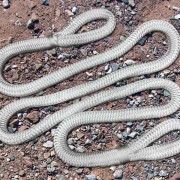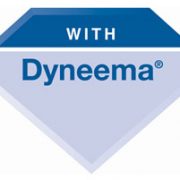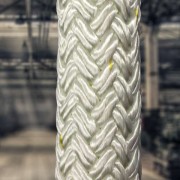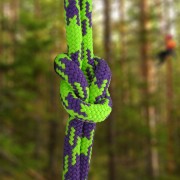Dyneema® Fibre – Characteristics
in Material CharacteristicsDyneema® fibre is the brand name for High Modulus Polyethylene (HMPE) fibre also referred to as Ultra High Molecular Weight Polyethylene (UHMWPE ).
Lighter than water, Dyneema® fibre is 15 times stronger than quality steel on a weight to weight basis and 7 times stronger based on a matching diameter. It is very static and very resistant to abrasion, UV, moisture and chemicals.
| CHARACTERISTICS | |
| Strength | Very high |
| Stretch | Very low, ~1% stretch while pulling @ 30% of the minimum break strength |
| Creep* | Low** |
| Weight | Very light (0.98 SG) |
| Melting point | 300°F (149°C) |
| Long term max temp | 158°F (70°C) |
| Bleaches / Solvents | Excellent |
| Weak acids / alkali | Excellent |
| Strong acids / alkali | Excellent |
| Abrasion resistance | Very Good |
| Mildew / aging / UV | Excellent |
*Creep is a function of load and time ** Low-creep (SK-78) and no creep (DynaMax)
Standard ABL products made with this fibre include SupreemX-12™, TorX-12™, CoreX-12™, HardLine™.
Vectran® Fibre Characteristics
in Material CharacteristicsVectran® fibre is a multi-filament yarn made from Liquid Crystal Polymer (LCP) melt-spun to form fibres with extreme strength and virtually no creep. It is 5 times stronger than steel on a weight to weight basis and 10 times stronger than aluminium. Vectran® fibre is dimensionally stable and exhibits excellent thermal stability from cryogenic temperatures up to elevated temperatures.
| CHARACTERISTICS | |
| Strength | Very high |
| Stretch | Extremely low, less than 1% stretch while pulling @ 30% of the minimum break strength |
| Weight | Heavy (1.39 SG) |
| Melting point | 625°F (329°C) |
| Bleaches / Solvents | Excellent |
| Weak acids / alkali | Excellent |
| Strong acids / alkali | Some strength loss in alkali at high temperatures. |
| Abrasion resistance | Good |
| Mildew / aging / UV | Good, UV causes degradation |
Standard ABL products made with this fibre include Vectro-12™, Vantage™.
Technora® Fiber – Characteristics
in Material CharacteristicsTechnora® is an para-aramid fiber made from copolymers, it has high tensile strength and excellent resistance to heat and chemicals (especially acids and alkalis).
| CHARACTERISTICS | |
| Strength | Very high (weight for weight, it is 8 times as strong as steel) |
| Stretch | Very low ~1.2% @ 30% |
| Creep | low |
| Weight | Heavy (1.39 SG) |
| Decomposition point | 800F – 952F (427C-511C) |
| Bleaches / Solvents | Poor / Excellent |
| Weak acids / alkali | Good |
| Strong acids / alkali | Poor |
| Abrasion resistance | Fair to Good |
| Mildew / ageing / UV | Excellent |
| Water Absorption (fibre) | 0% |
Polypropylene Fibre Characteristics
in Material CharacteristicsPolypropylene fibre (PP) is an olefin fibre, olefin fibres float on water as they have the lowest specific gravity of all fibres.
- MFP (Multi-filament Polypropylene) – This fibre yarn is made with many long continuous filaments measuring less than 0.1mm in diameter. This fibre has a soft feel and
- Mono-filament Polypropylene – This yarn is made with single filaments ranging in diameters from 0.03mm to 0.3mm, products made with mono-filament polypropylene are very coarse and generally do not feel nice to the touch.
| CHARACTERISTICS | |
| Strength | Weak |
| Stretch | High, ~15% stretch while pulling @ 30% of the minimum tensile strength |
| Weight | Very light (0.94 SG) |
| Melting point | 300°F (149°C) |
| Bleaches / Solvents | Excellent |
| Weak acids / alkali | Excellent |
| Strong acids / alkali | Excellent |
| Abrasion resistance | Poor – Good |
| Mildew / ageing / UV | Excellent resistance to mildew / adequate UV* |
*UV resistance can be improved by adding a UV resistant coating.
Standard ABL products made with this fibre include Brizo™, Double-Lite™.
Nylon Fibre Characteristics (poly-amide fibre)
in Material CharacteristicsNylon fibre (poly-amide fibre) has the highest elasticity compared to other conventional fibres. Nylon has greater resistance to abrasion than polyester and a good resistance to temperatures. Unlike other fibres, nylon loses 10-15% of its strength when wet however, if unused and left to dry, the lost strength is regained once the rope has been allowed to dry completely.
| CHARACTERISTICS | |
| Strength | Good |
| Stretch | High, ~5% – 12% stretch (dry) while pulling @ 30% of the minimum break strength |
| Weight | Moderate (1.14 SG) |
| Melting point | 420°F (215°C) |
| Bleaches / Solvents | Will bleach / Degrades in mineral acids |
| Weak acids / alkali | Resists |
| Strong acids / alkali | Will dissolve |
| Abrasion resistance | Excellent |
| Mildew / Ageing / UV | Excellent / Excellent / Degrades after prolonged exposure |
Standard ABL products made with this fibre can be seen here www.atlanticbraids.com/products/by-material/nylon.
Polyester Fibre Characteristics
in Material CharacteristicsPolyester fibre (polyethylene terephthalate fiber PET) owes much of its renowned durability to the fact that it is UV resistant and does not quickly lose its strength due to cyclic loading (proper repeated use). Nylon has better abrasion resistance however, polyester performs better against the combination of friction and heat due to its high melting point.
| CHARACTERISTICS | |
| Strength | Good |
| Stretch | Low ~3% – 8% @ 30% |
| Weight | Heavy (1.38 SG) |
| Softening point | 465°F (240°C) |
| Melting point | 500°F (260°C) |
| Bleaches / Solvents | Excellent |
| Weak acids / alkali | Good |
| Strong acids / alkali | Moderate |
| Abrasion resistance | Excellent |
| Mildew / aging / UV | Excellent / Good / Degrades after prolonged exposure |
Standard ABL products made with this fibre can be found here www.atlanticbraids.com/products/by-material/polyester.
Our Location
Contact Us
Atlantic Braids Ltd.
#15 Concession Road 1, Chute à Blondeau, ON
K0B 1B0, Canada
Phone: (613) 674-2728 Fax: (613) 674-3192
Office Hours: 8am – 5pm Mon.-Thurs. | 8am – 4pm Fri.








